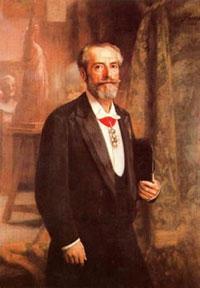Frédéric Bartholdi

Frédéric Auguste Bartholdi was born on 2 August 1834 in Colmar (Haut-Rhin department). During his childhood in Paris, he demonstrated his artistic gifts and his future became clear as he visited the capital’s workshops and monuments during his studies at Lycée Louis-le-Grand.
From 1843 to 1851 he went to painter Ary Scheffer’s workshop, and during school holidays in Colmar he took drawing lessons with Mr Rossbach.
In 1852, Bartholdi moved into a workshop in Paris and the following year he filled one of his first orders for his home town – a statue of General Rapp, inaugurated in 1856.
At 21, he took a trip to the Middle East, Egypt and Yemen.
Along the Nile he discovered a rich civilisation whose monuments have survived the ages. This enriching, 8-month journey enabled Bartholdi to bring back sketches, drawings and photographs and, more importantly, it confirmed his vocation in statuary.
In 1857, he presented a project for a fountain that was selected in a competition organised by the city of Bordeaux, but it did not take shape for another 42 years, in Lyon, on the Place des Terreaux.
From 1863 to 1869, in Colmar, he produced the Martin Schongauer monument and the fountain dedicated to Admiral Bruat, took a second trip to Egypt, and sculpted his Petit Vigneron, exhibited at the covered market in Colmar.
In 1870, he made the first model of the Statue of Liberty Enlightening the World. During the Franco-Prussian War he was an officer in the national guard, then aide de camp for General Garibaldi and a government liaison agent. Angered by the loss of Alsace-Moselle, Bartholdi said to his friend Edouard de Laboulaye, "I will fight for freedom, I call upon all free people. I will try to glorify the Republic over there, while waiting to find it once again at home." He left for the United States, seeking to ensure Franco-American friendship.
In 1872, he produced "The Curse of Alsace" and prepared a funerary monument for the National Guards fallen during the war. In 1873, the statue of Vauban was inaugurated in Avallon. In 1874, he produced bas-reliefs for the Unitarian Church of Boston.
In 1875, for the exhibition in Philadelphia, he completed a fountain and also produced a statue of Champollion. Then, with the founding of the Committee of the Franco-American Union, he got down to work on the Statue of Liberty Enlightening the World.
The hand and flame were completed in 1876 and exhibited at Madison Square for 5 years. That year, Bartholdi also produced a statue of La Fayette for the city of New York.
In 1878, the head of the future Statue of Liberty was exhibited at the Exposition Universelle in Paris.
From 1879 to 1884, he produced the Gribeauval monument in Paris, the Lion of Belfort, the statue of Rouget de Lisle in Lons-le-Saunier, and the statue of Diderot in Langres.
On 4 July 1884, France presented the United States with a statue of Liberty Enlightening the World. In 1885, a replica measuring a few metres in height was installed on Ile aux Cygnes in Paris, while its big sister boarded the "Isère". The statue was inaugurated in New York on 28 October 1886, and other copies of the work were later installed in Hanoi and Bordeaux.
From 1888 to 1891, Bartholdi produced the Roesselmann monument and the Hirn monument in Colmar, then the Gambetta monument in Sèvres.
From 1892 to 1895, he presented two works in Paris dedicated to La Fayette and Washington and a sculpture representing Switzerland assisting Strasbourg, while a statue of Christopher Columbus was shown at the Chicago World’s Fair.
In 1898, the Schwendi monument was inaugurated in Colmar.
In 1902, for the Place des Ternes in Paris, he produced a work dedicated to the “Aéronautes” (hot air balloons) of the Franco-Prussian War of 1870, “Les Grands Soutiens du Monde” (which can be seen in the courtyard of the Musée de Colmar).
In 1903, he completed the monument dedicated to Vercingétorix for the city of Clermont-Ferrand, based on a model created in 1870.
Frédéric Auguste Bartholdi fell ill and died in Paris on 4 October 1904.
In 1907, his widow left the artist’s house and models to the city of Colmar, where a monument to his memory was inaugurated.
In 1912 Belfort posthumously inaugurated the Trois Sièges monument.
The Bartholdi Museum opened in 1922, four years after the return of Alsace-Moselle to France.
His works included the monument to Sargent Hoff, Hero of the Franco-Prussian War of 1870, at Père-Lachaise Cemetary in Paris (division 4).

